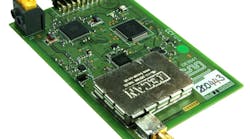Software-defined radios (SDRs) are often associated with military users, but they also bring enormous flexibility and versatility to commercial and industrial applications. To shorten the learning curve for those hoping to adopt SDR technology in their own systems, CML Microcircuits is offering their very compact model DE9941 SDR 1 Demonstration Board, which makes use of the company’s model CMX998 Cartesian Feedback Loop Transmitter, model CMX994 Direct-Conversion Receiver, and model CMX7164 Multimode Wireless Data Modem integrated circuits (ICs). The credit-card-sized demonstration board can be used to send and receive wireless data from 452 to 467 MHz using a wide range of secure modulation schemes, including quadrature amplitude modulation (QAM), frequency-shift-keying (FSK), and Gaussian minimum-shift-keying (GMSK) modulation (see figure).
The DE9941 SDR 1 Demonstrator Board can transmit and receive signals with 4/16/64-state QAM linear modulation, as well as 2/4-level FSK and GMSK. The board, which includes a 1-W power amplifier for transmission, is designed to be compliant with EN 302 561 radio requirements. The DE9941 incorporates a voltage-controlled oscillator (VCO) and phase-locked loop (PLL) for synthesized operation from 452 to 467 MHz. The SDR 1, which operates from a single +3.6-VDC, 2-A supply, measures a mere 83 x 55 mm and includes a single serial C-Bus interface. The demonstrator can connect directly to the firm’s model PE0002 Evaluation Kit Interface Card for ease of connection to personal computers (PCs).
The DE9941 SDR Demonstration Board has three CML Microcircuits radio ICs: the aforementioned models CMX998, CMX994, and CMX7164. The CMX998 transmitter covers a frequency range of 30 MHz to 1 GHz and supports a wide range of linear modulation schemes, including QAM, quadrature phase shift keying QPSK, {LC PI}/4 differential QPSK (DQPSK), eight-state phase-shift keying (8PSK) and orthogonal frequency division multiplex (OFDM). The broadband transmitter has low -148 dBc/Hz noise level and 360-deg loop phase-shift control for full command of phase modulation. It also has a wide gain-control range, an on-board error amplifier, and an integrated downconverter for feedback linearization. The transmitter IC communicates through a C-BUS (SPI compatible) serial interface.
The CMX994 receiver works with high-linearity downconversion mixers and several stages of baseband filtering for removal of out-of-band signals. The filters are followed by variable-gain baseband amplification. The bandwidths of the second-stage filters can be scaled for multiple-channel-bandwidth applications, such as 6.25-, 12.50-, and 25.00-kHz channels.
The receiver IC also incorporates a broadband in-phase/quadrature (I/Q) demodulator with frequency range of 100 to 940 MHz for direct-conversion applications. In addition, the IC boasts a broadband low-noise amplifier (LNA) with wide gain-control range. The receiver can support low-frequency operation to 50 MHz, and can operate with its own local-oscillator (LO) circuitry or an external LO. On-board LO generation is provided by an integer-N phase-lock loop (PLL) and voltage-controlled oscillator (VCO) with negative-resistance amplifier. The LO can operate in divide-by-2/4/6 modes for multiple-frequency-band operation as needed. The receiver IC is designed for operation with supplies from +3.0 to +3.6 VDC and can correct for DC offsets generated by off-channel signals in the SDR system. The receiver IC includes a low-power mode to reduce current drain as needed.
The CMX994 receiver’s outputs are differential I/Q signals which are applied to the analog-to-digital converters (ADCs) in the CMX7164 modem IC. The half-duplex model CMX7164 modem supports a wide range of modulation modes in multiple-channel arrangements. Together, the modem, transmitter, and receiver ICs combine to form a versatile SDR demonstrator board this is about the size of a credit card and designed to operate with a single low-voltage support for ease of integration in demonstration or prototype evaluation systems. It is a painless means for evaluating the benefits of SDR radio functionality for a wide range of systems—from commercial to military in their applications.
CML Microcircuits (USA), Inc., 465 Corporate Square Dr., Winston-Salem, NC 27105; (336) 744-5050, (800) 638-5577, FAX: (336) 744-5054, e-mail: [email protected], www.cmlmicro.com.
